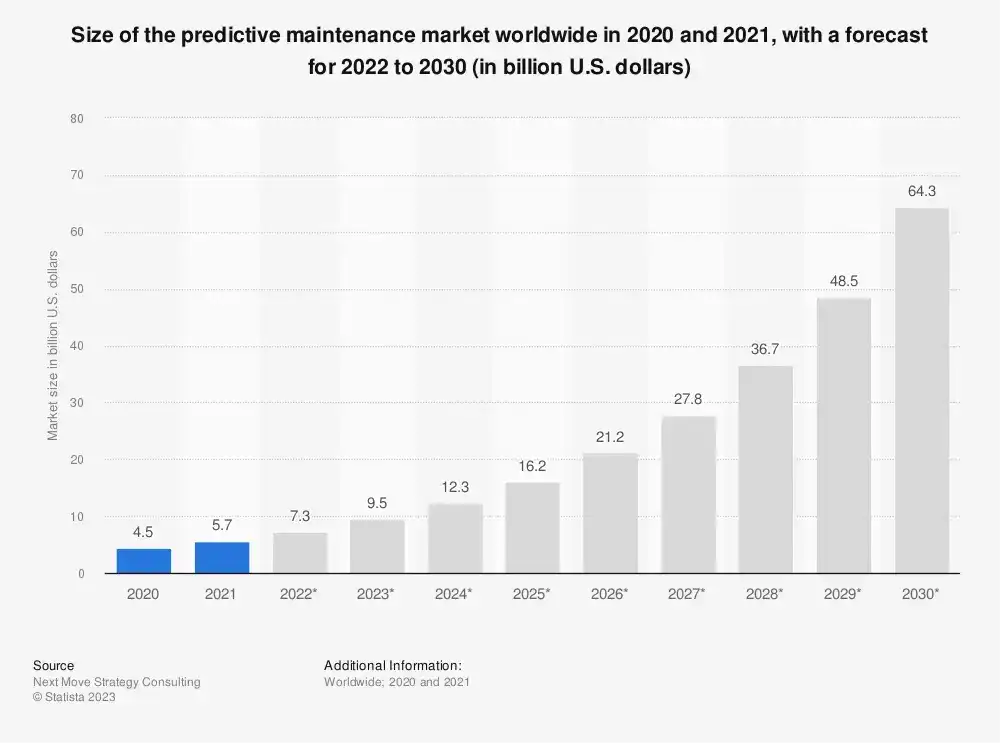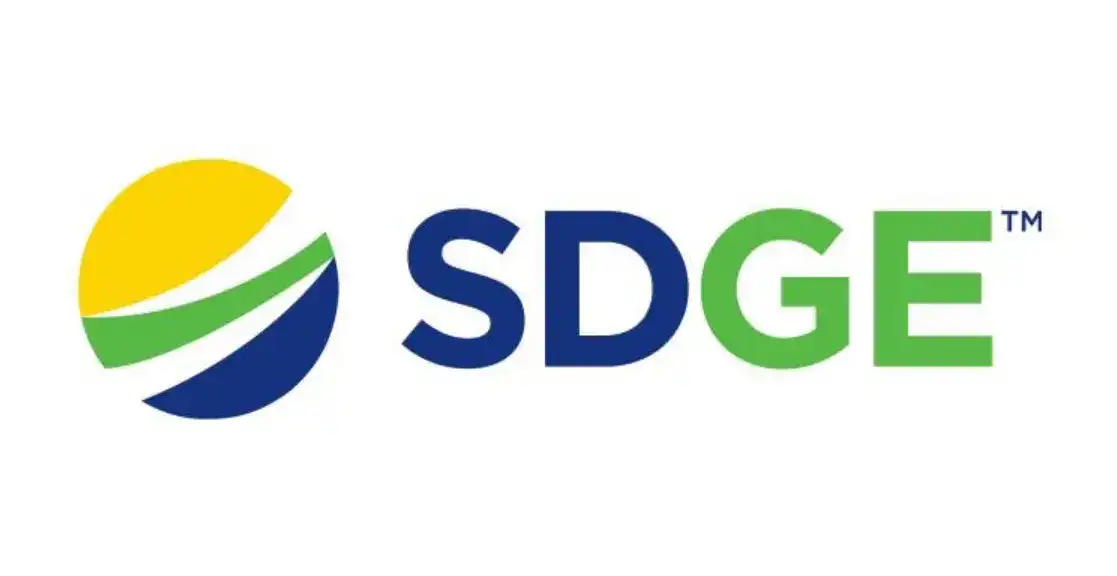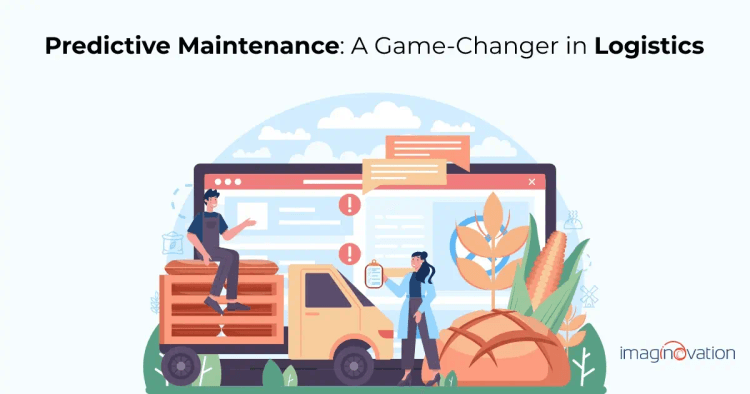Welcome to the age of Industry 4.0, where 'Predictive Maintenance' (PdM) is not just a buzzword. It's a game-changer.
No longer a fledgling concept, PdM is now revolutionizing how we manage assets. But what's all the fuss about? How can PdM elevate your asset performance and reliability?
In this blog post, we'll demystify PdM. We'll explore how it uses powerful data analysis and emerging tech to transform ordinary facilities into smart factories.
Ready to redefine 'maintenance'? Excited to see how PdM can optimize your operations?
Let's dive in!
What is Predictive Maintenance (PdM)?

With the predictive maintenance (PdM) market projected to reach a staggering 64.3 billion U.S. dollars by 2030, it's time to elevate your business strategies. The future is as promising as this approach.
But what exactly is Predictive Maintenance (PdM)?
PdM is a data and analytics-driven methodology that aims to predict and prevent unplanned downtime. It leverages cutting-edge technologies such as Artificial Intelligence (AI) and Machine Learning (ML) to continuously monitor equipment and systems.
The aim? To forecast their future state based on derived insights.
This valuable data is based on various factors including vibration, temperature, hour meter, flow and pressure, and energy consumption. Patterns extracted from this usage and environmental information help in correlating equipment with possible failures.
But PdM doesn't stop there. These insights actively contribute to predictive models, facilitating timely corrective interventions. Scores generated from this data provide a health indication of each piece of equipment. Simultaneously, key performance indicators (KPIs) are collected to identify assets deviating from normal patterns of behavior.
Even better, PdM allows for the generation of rules that can recommend actions on assets with a high probability of failure. These proactive alerts minimize risk, ensuring smooth operations.
In short, PdM is all about capitalizing on data, tech, and analytics to foresee, prevent, and manage equipment failure.
Benefits of Implementing Predictive Maintenance
Predictive maintenance models that are AI-enabled and blended with ML capabilities bring you solutions that can be tailored to your specific type of operation. Let's look at some prominent benefits.
- Improved supply chain visibility: With predictive maintenance, you can enjoy improved visibility of shipment status. Plus, it helps cut down costs that are related to late or off-schedule shipments.
- Reduced downtime and augmented life: According to a PWC report, PdM can boost uptime by 9%; plus, it extends the lifetime of aging assets by 20%. Thus, predictive maintenance can predict issues, and reduce downtime. Many companies have concrete plans to increase their maturity in PdM and make full use of Predictive Maintenance (PdM) 4.0.
- Reduced maintenance costs: According to a recent study, PdM can help save 8-12% over predictive maintenance models, and when it comes to reactive maintenance it can save around 40%. Further, as manufacturers come to know of potential failures weeks (or even months) ahead, it can reduce maintenance costs by 18-25%.
- Greater productivity: PdM saves the company time and money by boosting production efficiency. With reduced downtime and more efficient maintenance, equipment operate at maximum capacity. Plus, the quality is better, and you can enjoy improved production capacity, increased labor utilization, and equipment lifespan - all leading to higher productivity.
- Targeted maintenance: PdM enables technicians to perform maintenance based on insights that reveal failure patterns and correlations to specific components. Thus, facility maintenance technicians can perform targeted maintenance.
- Improved safety: According to PWC, PdM in manufacturing can reduce safety, health, and environmental risks by 14%. Thus, you can enjoy reduced workplace accidents and alert technicians on any imminent equipment failures.
Steps to Implement Predictive Maintenance
Step 1: Start with your most critical equipment
The first step should be to identify asset criticality. Typically, such assets are the ones whose failures lead to huge costs. Thus, what you'll need to account for as higher priority are two facets:
- Is the asset of high criticality?
- Is the asset more vital to production?
There are many tools that can help to rank the risk of priority of assets. One such tool is the ABC analysis. It has three criteria as a base to work on:
- frequency of failure
- level of difficulty in detecting the failure
- the impact caused by the failure of overall operations
With the analysis, you can classify assets into—high, medium, and low criticality. The predictive maintenance program must ideally include the high and medium critical assets. The focus helps to boost uptime and ensures brilliant results.
Step 2: Start training staff

The use of advanced tools that PdM requires will start churning results. The question is: will your staff be ready to read alerts and to act proactively to maintain and repair IoT tools?
The staff, including operators and technicians, are critical to a successful PdM program. Thus, ensuring that they are trained well to identify alerts and promptly maintain and repair assets will help with a quick turnaround.
Step 3: Set condition baselines
When deploying predictive maintenance, it is important to start with defining maintenance baselines. Let's look at what happens with a predictive maintenance strategy - you may set a target to service equipment after some hours of use (let’s say 10,000 hours).
With a PdM approach, you get the advantage that your baselines could involve conditions and performances in real-time. Thus, if a machine isn't functioning well - let's say is producing a lot of noise that is more than the baseline decibels set, it would send an alert. Further, the maintenance can be performed right away.
Step 4: Collate existing maintenance data to baseline prior performance
PdM needs data, and that includes in-service experience and steady-state operations. The data collated is compared with current operations. The analytics engine typically collects operating data over time. Further, it provides a baseline for creating and training the operating model.
Step 5: Install sensors and condition monitoring devices
You can start with the identification of sensors and condition-monitoring devices that can help you meet your set baselines. Once you find the right fit, you can install them. The devices could include an oil measurement, a vibration meter, or a thermal imagery camera.
Step 6: Connect devices to a CMMS
Next, you can connect the IoT devices and sensors to an effective computerized maintenance management system (CMMS) tool. The tool can help you plan, analyze, monitor, report, and optimize your maintenance activities. Plus, you can track and maintain assets, schedule maintenance, and store critical data.
Step 7: Track failure-related information
![]()
Once you have set your baseline conditions, and find tools, sensors, and software that get you the best diagnosis - it is easy to collate data automatically. Plus, you don't need a technician to get close to the equipment to keep a check.
When it comes to monitoring assets with PdM, you'll find both offline and online methods. You can choose the method for each plant, which impacts the maintenance costs and the profitability facets.
For offline, the sensors collect data manually, whereas online monitoring, uses AI. Plus, with IoT sensors installed in the equipment, you don't need the presence of a maintenance professional as the data is collected automatically.
Step 8: Notify the maintenance professionals to take action
Next, with the insights on the most critical assets, all you need to work on is to send alerts to the maintenance team for further action. An efficient way to begin is to run a pilot test for one or two of your most important assets. The test will help you understand how the PdM strategy is working in real-time.
Challenges to Implementing Predictive Maintenance
1. It's a huge investment
PdM needs a huge capital expenditure in technology and labor to perform efficiently. Thus, as a business owner, you'll need to consider the asset management costs, which include buying smart sensors to training the staff to work with new technology. Plus, you'll have to consider costs such as CMSS software, installation, security to be built in, skilled maintenance experts, etc.
Each company has a different business case, so it is best to work on a cost-benefit analysis to check the feasibility before implementing the PdM strategy.
2. Compatibility issues of smart sensors with current assets
Here's the thing: the price of sensors varies depending on the type of sensors you need for your operations. They range from $100 to thousands of dollars per sensor. It is quite a situation when some industrial machines are not compatible with smart sensors.
The situation would mean that the assets need to be altered to have sensors built into them. The good part—many ways can help to update and place sensors in your assets efficiently.
3. Untrained staff to work on new technology
PdM technology is a new approach, and the technology is niche - thus, the staff needs to be trained. The training will involve facets on how the staff can work with the new assets and also how to interpret the data. The regime will not only familiarize the staff with the new systems and technology but also help with the protocols to understand the processes.
4. Privacy and security concerns
Businesses need to be aware of concerns that exist mostly on the end user's side. With a PdM strategy, the production and factory data that is collected is sent and stored somewhere in a database.
Many firms are concerned with the security of the IoT Network, which also includes the privacy of their data. Some solutions place data on the cloud as well. However, the focus remains the same on the security of the network and keeping the data as safe as possible.
5. Staff reluctant to change
It is a general feeling that people are reluctant to change. The staff could have a feeling that their skills and knowledge will no longer be needed after implementing the PdM strategy. Thus, it is critical to have constant internal communication to have everyone on board and convinced about the benefits that the change will bring them and the organization. The buy-in from all stakeholders helps in the overall functioning.
Predictive Maintenance Success Stories
1. Frito-Lay's world-class North American manufacturing facility

Frito-Lay set up high-performance machines adopting the approach to preventive and predictive maintenance and reliability at their North American manufacturing facility. What's more: the Tennessee snack food giant announced a $200 million plant expansion.
Some achievements:
- Year-to-date equipment downtime is around 0.75%
- At PepsiCo’s Fayetteville, TN, Frito-Lay plant the unplanned downtime is around 2.88%
The backdrop:
The Frito-Lay plant produces over 150 million pounds of product per year, which includes Cheetos, Lays, Doritos, Ruffles, and more. The team adopts a PdM approach that enables real-time assessment of their equipment health, which predicts failures (and the remaining lifespan).
Best PdM practices adopted:
- PdM system supports in-depth planning and scheduling, along with highly upgraded technology, which includes vibration analysis and ultrasound, and well-crafted PdM processes.
- For corrective work, the planners and schedulers go to the storage area and check out several parts, and then the mechanics are handed the right equipment, parts, and tools to maximize wrench time.
- The team uses condition-based approaches blended with the previously referenced predictive technologies, which include ultrasound, thermography, and vibration analysis.
- Vibration analysis is used in mechanical applications.
- IR analysis on a quarterly basis is performed by an in-house team for all motor control center rooms including electrical panels.
2. San Diego Gas & Electric (SDG&E) Company adopting predictive maintenance

San Diego Gas & Electric (SDG&E) Company leads the way through innovative ways that can predict asset failures. The company is exploring adopting emerging technologies such as AI and ML to improve operations and maintenance.
Some achievements:
- The company developed iPredict, which is a first-of-its-kind asset failure predictor for electricity distribution
- Plus, they explored and proved that the technology could be a new tool for utilities and enhance electric grid reliability
The backdrop:
In the United States, in most congested urban areas there are many utilities that run underground power lines. Consequently, equipment failures are hard to find and fix because of the underground lines. Further, the underground assets at SDG&E make up over 60% of the total distribution grid and are approaching over 40 years of age. The assets require advanced maintenance approaches to avoid any unplanned downtime.
Yet another concern is that T-splice failures can trigger outages that impact customers' lives and can cost tens of thousands of dollars to resolve. Plus, the wildfires have increased by roughly 800% in the last few years, which makes situational awareness and maintenance of above-ground equipment and vegetation assets very important.
Best PdM practices adopted:
- The T-splice initiative at SDG&E uses iPredict for electricity distribution, which is a co-developed solution.
- The system data is correlated with granular high-frequency sub-cycle data, which allows algorithms to recognize and interpret anomalies and early signs of any asset failure in near real time.
- Plus, SDG&E will use the solution to predict overhead equipment failures apart from underground assets.
3. Noranda Alumina plant's new solution
It’s a fact that modern process-centric methods can make maintenance more efficient. With Manufacturing Intelligence (MI) the plant can move seamlessly to predictive maintenance (PdM), saving your organization time, effort, and money.
The Backdrop:
Russell Goodwin, a reliability engineer at the Noranda Alumina plant explains how four hours of downtime is about 1 million dollars’ worth of lost production. Plus, the grease completion rate touched 92% in 2021. Further, the plant in Gramercy, LA, experienced a 60% decline in bearing changes after trying a new lubrication solution (in its second year of application). Further, it helped save around $900,000 in bearing purchases and avoided costly downtime.
Some achievements:
Kip Smith, CEO of Noranda Aluminum explains how they achieved their goal of eliminating unplanned downtime – it was by understanding and eliminating process variability. Further, they focused on refining preventive maintenance cycles and enhancing their planned downtime efficiency to achieve their goal.
Best PdM practices adopted:
- The plant has a practice of tracking all motors and gearboxes at 1,500 rpm and higher with vibration readings.
- Ultrasonic PdM was introduced to the plant in 2019.
- At first, the grease completion rate was 67%. However, the 401 Digital Grease Caddy helped put in the right amount of grease. It would give insights into the greasing date, time, and quantity. Thus, completion rates subsequently increased to around 92% in 2021 to date.
Wrapping Up
Across industries, many are making the switch to smart factory solutions that are grounded on the predictive maintenance approach. With PdM's proven benefits and the potential to optimize maintenance tasks in real-time, it's time for enterprises to consider moving toward the approach. If you haven't yet considered, now is a great time for you to start the journey!
Embrace Predictive Maintenance With Imaginovation
It’s time you embrace predictive maintenance and drive a successful maintenance operations transformation.
If you don’t know how to develop customized logistics solutions around PdM, talk to us. We can help walk you through the entire PdM strategy and approach.
We’ve helped many enterprises with creating futuristic digital solutions and would be happy to meet you wherever you are on your digital transformation journey.
Let’s talk.
Ready to build an app, but not sure where to start?
We've got you covered. Click the button below to get started.





